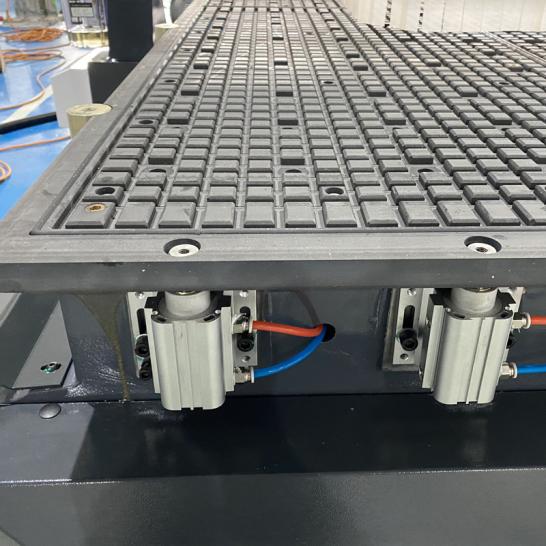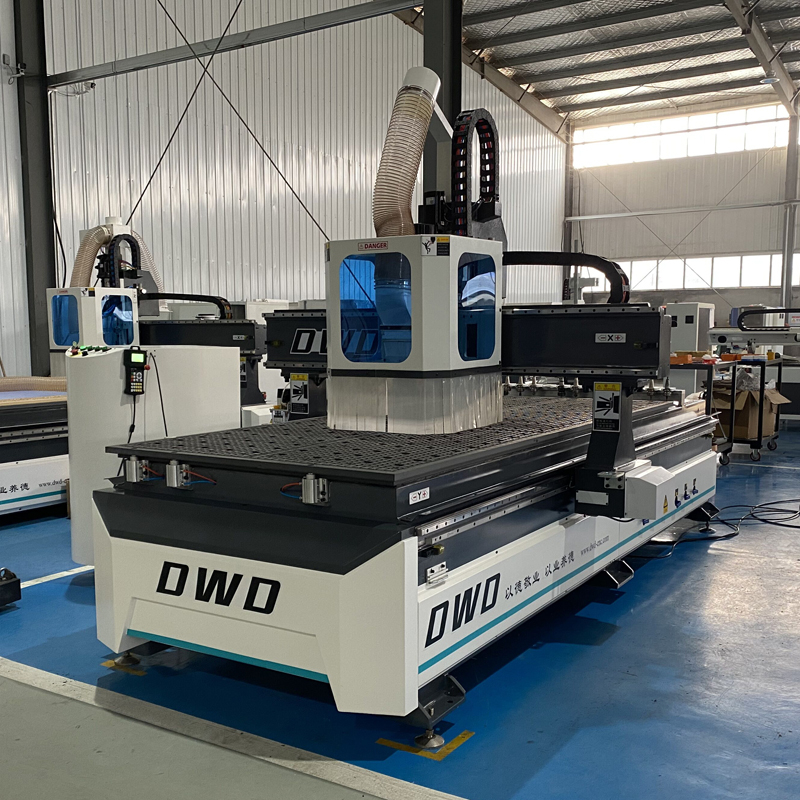close
Choose Your Site
Global
Social Media

Views: 0 Author: Site Editor Publish Time: 2025-07-15 Origin: Site
When it comes to modern manufacturing, industrial CNC router tables are game-changers, offering precision, automation, and efficiency for a variety of industries. However, even the most advanced machines can’t reach their full potential if not properly used. Whether you’re a seasoned professional or new to the world of CNC technology, understanding the common mistakes made when using a CNC router is essential. These errors can lead to costly delays, wasted materials, and reduced output.
In this article, we’ll guide you through the most common mistakes made when using an industrial CNC router table, focusing on the Cabinet making CNC router. By avoiding these mistakes, you can ensure that your machine performs optimally, cutting down on errors and ensuring a smooth workflow.
You'll learn practical tips on how to enhance your operations, optimize your machine setup, and avoid potential pitfalls that could hurt the quality of your work and the longevity of your equipment.
Calibration is often one of the most overlooked aspects of using a CNC router, but it’s one of the most critical. Skipping proper calibration can lead to misalignments and uneven cuts, which can ruin a project before it even begins.
Calibration ensures that the Cabinet making CNC router cuts with precision. Whether it's tool offsets, alignment, or bed leveling, everything must be accurately set before starting any work. Without these checks, you might experience cuts that are off-center or inconsistent, leading to wasted materials and time.
Check machine alignment before every major project.
Test tool offsets to ensure the correct depth of cut.
Level the bed properly, especially when working with large sheets of material like plywood or MDF.
A few minutes spent on calibration can save hours of rework later on. In cabinet making, where precision is key, calibration is non-negotiable.

One of the most common mistakes when using a CNC router is selecting the wrong tooling for the material. The Cabinet making CNC router works with various materials, including wood, MDF, and even composite materials. Each material requires a specific type of tooling to ensure the best results.
Using the wrong bit can cause burns, jagged edges, or even break the tool itself. For example, a softwood router bit won’t work well with aluminum, and using a dull tool on hardwood will result in a poor finish.
Match the bit to the material: Use up-cut spiral bits for clean wood edges, and carbide-tipped tools for harder materials.
Tool diameter matters: Larger diameter bits can achieve faster cuts, but they may also introduce more heat and stress on the material.
Consider the cut type: For profile cuts in cabinet making, compression bits or downcut bits are often necessary for clean edges.
By understanding the nuances of tool selection, you’ll improve both the speed and quality of your cuts.
Modern CNC routers, especially in cabinet making, rely heavily on software to ensure the correct movement of tools and material handling. Ignoring or not double-checking your software settings can lead to mistakes such as incorrect feed rates, depth of cuts, or misalignment of paths.
When working on cabinet making CNC routers, software errors can quickly escalate. If the toolpath is set incorrectly, the machine could end up cutting deeper than intended or too quickly, which can result in damaged materials or tools.
Check feed rates and spindle speeds: Ensure these match the material you are cutting.
Run a simulation: Most modern CNC software allows for simulation before starting the actual cut. This feature can catch any issues before they arise.
Review toolpath: Verify that the paths are optimized for both speed and precision.
By paying close attention to software settings, you prevent costly mistakes and ensure your cabinet making CNC router works smoothly.
Even with the best machine, a cabinet making CNC router can’t perform well if the material isn’t secured properly. Poor material setup can cause the material to shift during cutting, leading to inaccurate cuts and wasted time.
In cabinet making, the materials used can vary greatly in weight, texture, and size. Securing these materials firmly is essential to ensure consistent cuts. When working with large sheets, such as plywood or MDF, a slight shift in the material can ruin the entire job.
Use clamps or vacuum systems: Strong clamps or a vacuum hold-down system can ensure that your material stays in place.
Clean the material surface: Dust or oil on the material surface can affect how well it adheres to the machine bed.
Check for flatness: Ensure that the material is flat and free of warping. Warped materials are harder to hold down and lead to inaccurate cuts.
By focusing on securing your material, you can prevent unexpected issues and ensure a flawless cabinet making CNC router experience.

CNC routers are precision machines, and like all precision equipment, they require regular maintenance to keep performing at their best. Skipping maintenance can lead to decreased accuracy, faster tool wear, and even machine breakdowns.
In cabinet making, where machines are often running long hours, maintenance becomes even more crucial. Dust, debris, and wear and tear on moving parts can slowly degrade performance, leading to more significant issues down the road.
Daily cleaning: Remove dust and debris from the machine and surrounding areas.
Lubricate moving parts: Regular lubrication ensures smooth operation and prevents premature wear.
Inspect belts and screws: Make sure that belts are tight and that screws are secure.
By establishing a regular maintenance routine, you can ensure that your cabinet making CNC router continues to perform optimally for years to come.
Rushing through setup, calibration, and other critical steps can lead to costly mistakes. In cabinet making, where precision is essential, taking shortcuts can lead to poor-quality results, tool damage, or even accidents.
While deadlines may push you to move quickly, rushing often results in errors that take far more time and money to fix. Whether it’s skipping a test cut or rushing through the software settings, moving too fast can lead to irreversible mistakes.
Take your time during setup: Double-check every step to make sure the machine is properly calibrated and ready.
Run test cuts: Always perform small test cuts before starting a full run.
Don’t skip safety checks: Safety should always come first. Skipping these checks increases the risk of accidents.
Taking the time to carefully set up your cabinet making CNC router ensures that the end result will be worth the extra effort.
Even the best cabinet making CNC router won’t reach its full potential without well-trained operators. Untrained or inexperienced staff can make costly mistakes, causing errors in material handling, tool setup, or even machine operation.
CNC machines, especially those used for cabinet making, are complex, and operators need to understand not only how to use the machine but also how to troubleshoot issues. Proper training ensures that mistakes are minimized and that the machine runs smoothly.
Machine operation: Teach your team how to set up, calibrate, and run the CNC router.
Tool maintenance: Train operators to recognize when tools need sharpening or replacement.
Troubleshooting: Ensure operators can identify issues and solve them without causing further damage.
Investing in training for your team ensures that your cabinet making CNC router is operated efficiently, which boosts productivity and quality.
Avoiding common mistakes when using an industrial CNC router table is key to maximizing productivity, reducing waste, and achieving high-quality results in cabinet making. From proper calibration and tooling to regular maintenance and training, these steps ensure that your cabinet making CNC router operates at peak efficiency. By paying attention to these details, you can avoid costly errors, extend the lifespan of your equipment, and ultimately deliver superior results for your customers.
If you’re looking to optimize your CNC router experience and avoid these common pitfalls, make sure to work with reliable, high-quality equipment. Consider DWD’s cabinet making CNC routers, designed for precision and durability, backed by excellent customer support to ensure your business stays on track.
A: Calibration ensures that the CNC router operates with precision. Without proper calibration, you may encounter misalignment, uneven cuts, and unnecessary material waste.
A: Selecting the appropriate tool depends on the material you're cutting. For wood, carbide-tipped tools are ideal, while harder materials require specialized bits. Always match the tool to the task.
A: Regular maintenance is crucial. Perform daily cleaning, weekly lubrication, and monthly inspections to ensure optimal performance and prevent breakdowns.
A: No, different materials require different settings. Ensure you adjust the feed rate, spindle speed, and toolpath according to the material type to avoid damage and inefficiency.
A: Proper training, regular calibration, correct tooling, and maintenance are essential to ensure safe and efficient CNC router operation.
Copyright 2022 DWD MECHATRONICS CO.,LTD
Sitemap |Technology by leadong.com